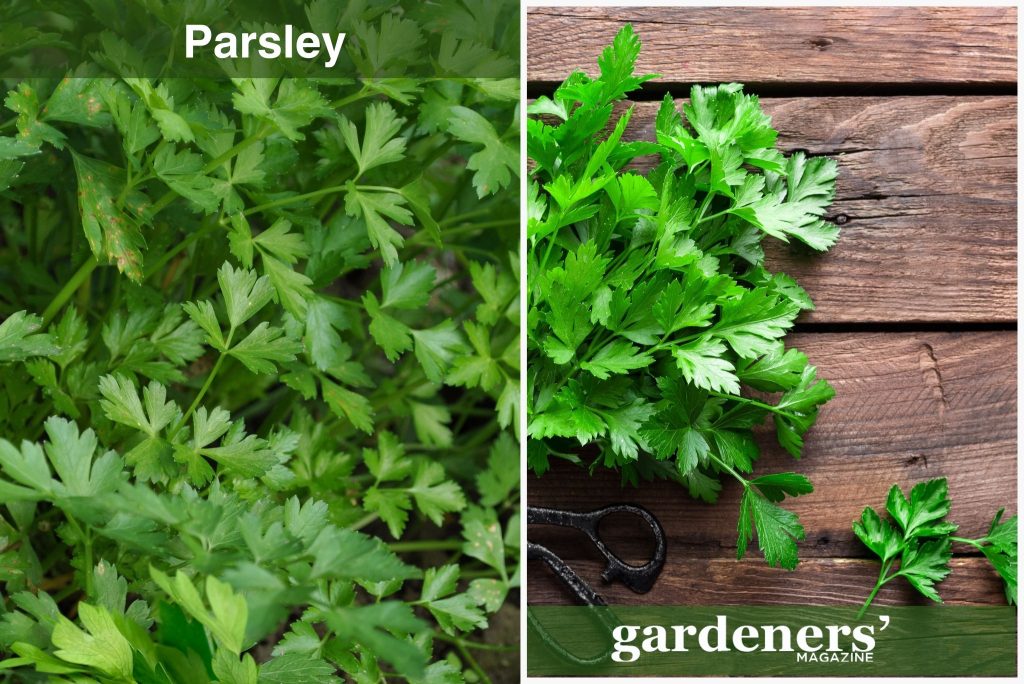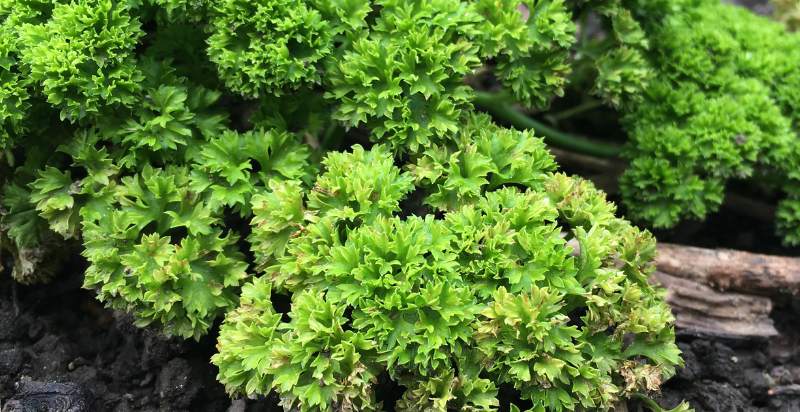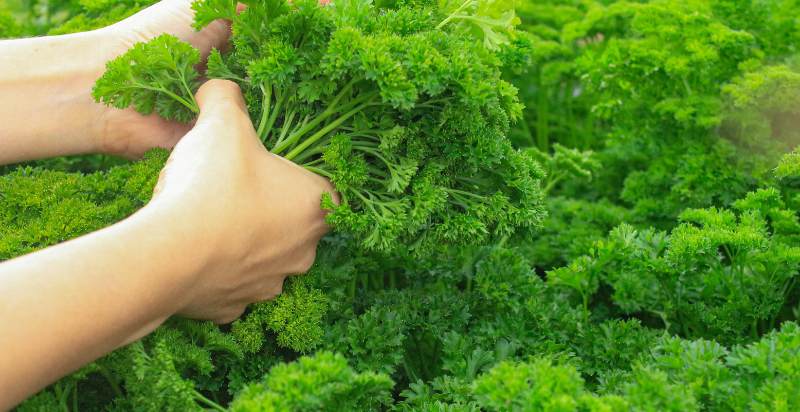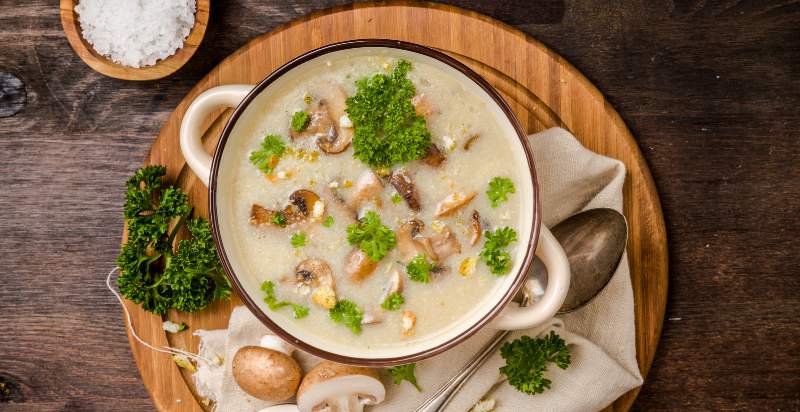Parsley plants are a type of herb that has been around for centuries, prized for their culinary and medicinal properties. It is native to the Mediterranean region and has become widely used in cooking worldwide. Parsley is also known as Petroselinum crispum or garden parsley.
This plant is a biennial, meaning it takes two years to complete its life cycle (though some varieties may act as annual). Parsley can be grown outdoors in gardens or containers, but it can also be grown indoors on a sunny windowsill and harvested throughout the year.
This article will discuss the different types of parsley plants, how they are grown, their health benefits, and some tips on using parsley in your cooking.
About Parsley:
Parsley, also known as Petroselium crispum, is a biennial herb that has bright green, divided leaves. It originally hails from the Mediterranean region and is now grown all over the world. There are two types of parsley: flat-leaf (Italian) and curly-leaf. The flat-leaf variety is known for having a more delicate flavor, while the curly-leaf taste has a stronger, more pungent taste. Both flat-leaf and curly-leaf parsley can be used in cooking as a garnish or as an ingredient in dishes such as soups, salads, sauces, and stews.

History of Parsley Plant:
Parsley has been used since ancient times, and references to it can be found in Greek and Roman texts. It was believed that parsley possessed the power to ward off evil spirits and cure bad breath. In medieval Europe, parsley was used as a medicinal herb and also as a symbol of rebirth because of its ability to thrive even in harsh winter temperatures. Today, parsley is most commonly used as a culinary herb, but it still retains some of its traditional healing properties.
Types of Parsley:
There are three main types of parsley: flat-leaf (Italian), curly-leaf, and root.
- Flat-leaf (Italian) is grocery stores’ most common type of parsley. It has a mild flavor with a hint of bitterness and adds flavor to dishes without overwhelming them.
- Curly-leaf parsley has a more pungent taste than flat-leaf varieties, and its leaves have an almost ruffled appearance. This parsley can be used as a garnish or an ingredient in recipes.
- Root parsley grows with attached roots that can be eaten, as well as leaves. Its flavor is much more intense than the other two types of parsley.
Parsley Nutrition:
Parsley is an excellent source of vitamins A, C, and K. It also contains important minerals such as iron, calcium, and magnesium. Parsley is a good source of antioxidants that can help fight free radical damage in the body. Additionally, parsley is high in dietary fiber, which helps to regulate digestion and promote healthy gut bacteria.
Parsley in Culture and Language:
Parsley, known as “perejil” in Spanish, is a staple herb in kitchens around the globe. It’s celebrated for its vibrant flavor and versatility in dishes, especially in Spanish-speaking cultures. This leafy green’s presence in culinary traditions spans centuries, highlighting its enduring appeal.
Beyond “perejil,” parsley is embraced by various names across different cultures, each reflecting the herb’s integral role in their culinary practices. For instance, in French, it’s called “Persil,” and in Italian, “Prezzemolo,” showcasing its widespread appreciation.
These diverse names not only point to parsley’s global popularity but also to its adaptability in a myriad of dishes, from garnishes to main ingredients. Understanding the common names and uses of parsley enriches our appreciation for this herb, connecting us with the myriad ways it enhances flavors and brings dishes to life across cultures.
Uses of Parsley:
Parsley leaves are highly aromatic and have a distinct flavor with hints of lemon, celery, and nutmeg. They are used as a garnish, to season food dishes, and to add color and texture. Parsley can be used fresh or dried, but it is best when freshly chopped. The leaves are often added to salads, soups, sauces, sandwiches, and pizzas. Parsley is used in moderation and provides many vitamins and minerals, including C, A, K, and folate.
Culinary Uses of Parsley:
Parsley has a delicate flavor, so it should be added at the last minute when preparing foods like fish and vegetables or sprinkled on top of finished dishes for extra flavor. It pairs nicely with garlic, onion, citrus flavors, and other herbs like basil or oregano. Parsley is often combined with lemon juice to make a popular Italian condiment called gremolata. Parsley can also make flavorful sauces, pestos, and soups.
Medicinal Uses of Parsley:
Parsley has a long history of medicinal uses and is believed to have powerful anti-inflammatory properties. It is high in antioxidants that help protect the body from disease-causing free radicals. Parsley is also thought to aid digestion, reduce bloating, and act as a diuretic. The herb can be raw or made into teas, tinctures, or capsules for medicinal purposes.
How to Grow:
Growing parsley leaves is relatively easy. The first step is finding a place with well-draining soil and at least 6 hours of direct sunlight daily. Once you have chosen the right spot, prepare your soil by adding organic matter such as compost or aged manure. This will improve drainage and nutrition in the soil, which both help parsley plant grow better.
Next, it’s time to plant your parsley seeds. Plant them about 1/4 inch deep and space them apart by 2-3 inches on either side of the row. Then water them generously and mulch around the base of the plants to help retain moisture in the soil. You can also fertilize once every two weeks using a balanced fertilizer like 10-10-10.
Once your parsley plants have germinated, thin them to 4 inches apart, so they have plenty of room to grow and spread out. Keep the soil moist throughout the growing season, but do not overwater, as this can cause root rot. Ensure you are also removing any weeds or grass around the parsley plants to prevent competition for resources.

How To Care
Parsley is a relatively low-maintenance plant that requires some basic care. But there are a few things you need to keep in mind, such as :
Soil Requirements:
When growing parsley, it’s important to provide it with soil that drains well and provides plenty of nutrients. A nutrient-rich soil will ensure your plants grow big, healthy leaves. Aim for a soil pH between 6.0 to 7.0 or slightly acidic to neutral. If unsure about your soil, have it tested or use a soil pH test kit.
Sun and Temperature Requirements:
Parsley prefers full sun but can tolerate partial shade. In warmer climates, provide some afternoon shade to prevent the leaves from wilting in the heat. Parsley will grow best when temperatures are between 65°F and 70°F (18°C – 21°C). Avoid planting parsley outside until all danger of frost has passed, as parsley cannot survive even light frosts.
Watering Needs:
Parsley needs regular watering to keep its soil moist, but don’t overdo it—allowing the top layer of soil to dry between waterings is best. Water the plants deeply, drenching the soil to a depth of at least six inches and avoiding wetting the leaves. If you’re growing parsley in containers, water them daily or every other day during hot, dry weather.
In addition, you should be deadheading any yellowing or dying leaves to keep the plant looking its best and prevent the disease from invading the rest of the foliage.
Lastly, remove any weeds around your parsley plant to prevent competition for resources and ensure they are getting all of the nutrients they need to thrive. With proper care, you can enjoy fresh, flavorful parsley for your recipes all season long.
How to Trim
Trimming parsley plants is key to encouraging bushy growth and prolonging their productivity. Here’s how to do it effectively:
- Start Early: Begin trimming parsley when the plant has several sets of leaves, usually when it’s about 6 inches tall. This encourages branching.
- Use the Right Tools: Clean, sharp scissors or pruning shears are best to avoid damaging the delicate stems.
- Cut Above a Leaf Node: Always cut the stems above a leaf node (the point where leaves grow from the stem). This spot will sprout new branches.
- Harvest Outer Leaves First: Trim the outer, older leaves first, which allows the inner, younger leaves to receive more sunlight and grow.
- Don’t Overdo It: Never remove more than one-third of the plant at a time. Over-trimming can stress the plant and slow its growth.
- Regular Harvesting: Regularly harvesting the top leaves can also serve as a form of pruning, promoting a fuller plant.
- Post-Flowering Care: If your parsley plant begins to flower, trim off the flower stalks at their base. Flowering can cause the plant to focus on seed production, reducing leaf growth.
How To Harvest:
Once your parsley plants have grown tall and full of lush green leaves, it’s time to harvest them! The best time to harvest is in the morning before the heat of the day sets in, as this preserves the essential flavor and aroma compounds. Start by snipping off individual leaves using a pair of gardening scissors or a sharp knife, careful not to cut into branches or stems. You can also cut off whole sprigs if necessary.
When harvesting parsley, it’s important not to take over one-third of the foliage at a time, as this could shock the plant and affect its growth. Once you’ve harvested the desired amount, store your parsley in a plastic bag or container in the refrigerator for up to one week. Enjoy your fresh herbs, and remember to keep caring for your parsley plants so they can continue to thrive!

Seasonality and Availability of Parsley Plant:
Parsley is a herb that grows in different climatic zones in the United States. Its seasonality and availability vary according to the growing conditions in these zones. In the warmer southern zones, parsley can be planted during cooler fall months and grown throughout the winter. This helps to avoid plant bolting, which is the premature seeding of the plant due to excessive heat. In contrast, parsley seeds are best sown early in the spring in the cooler northern zones when the soil is workable. Here, parsley thrives throughout the spring, summer, and early fall and can even survive the first few frosts due to its hardy nature. Its hardiness can enhance its flavor by converting starches into sugars.
For gardeners in areas with transitional middle zones, parsley can be planted continuously from late winter to late summer, depending on the specific local climate. This staggered planting approach ensures a regular crop without being affected by the plant’s natural biennial seed cycle. Regardless of the zone, indoor cultivation can be a practical option. Parsley’s compact size and low light requirements make it ideal for growing on windowsills, where it can receive around four hours of direct sunlight daily. This method provides a year-round supply of fresh parsley, irrespective of outdoor growing restrictions imposed by winter temperatures in northern zones.
How To Preserve Parsley Leaves:
Parsley leaves are best when used fresh, but if you want them to last longer, there are several ways to preserve them. One way is by drying – snip off the leaves and spread them out on a paper towel or cloth napkin until they are completely dry. You can also freeze them by chopping them up and storing them in an airtight container or zip-top bag for up to 6 months.
To make a flavorful parsley pesto, blend fresh parsley leaves, garlic, olive oil, and salt until it forms a smooth paste. You can also steep or simmer the chopped leaves in butter or oil for a delicious seasoning that can be stored in an airtight container for up to several weeks. With these preservation methods, you’ll enjoy fresh-tasting parsley all year round!
How To Use Parsley Leaves:
Parsley leaves are most commonly used as a garnish but have many culinary uses beyond their good looks. The mild flavor of parsley complements dishes like roasted vegetables, pasta, or fish and can also be used to make flavorful pesto sauces. You can chop fresh parsley leaves and mix them into salads or sandwiches for a bright flavor. They are also great in soups, stews, and other dishes that need extra herby goodness.
For an easy way to enjoy the benefits of parsley, try steeping the chopped leaves in boiling water for 10-15 minutes to make tea. This herbal “tea” is loaded with antioxidants and vitamins that support heart health and digestion and aid in detoxification. So get creative with parsley – so many delicious ways you can enjoy this healthy herb!

Tips for Using Parsley:
Parsley has a mild flavor, so it pairs well with almost any dish. Here are some tips for using parsley in your cooking:
- Use it to garnish soups, salads, and other dishes for a pop of color.
- Add finely chopped parsley to sauces and marinades for an extra herby flavor.
- Use it as a topping for roasted vegetables or potatoes.
- Sprinkle fresh parsley over grilled meats like steak or chicken.
- Mix chopped parsley into pesto or hummus for added flavor.
Conclusion
Growing your parsley is easy, and the rewards are well worth the effort. With just a little care and attention, you can enjoy bright green, flavorful parsley all season long! Whether it’s a flat leaf or a curly leaf that you prefer, growing parsley is an excellent addition to any garden. With this guide in hand, you’re ready to get started! Happy planting!
- Everything You Wanted to Know About Red Tamarillos - June 2, 2025
- A Guide to Tulips: Everything You Need to Know & More… - June 2, 2025
- Guanabana: Description, Flavor, Benefits, And Uses - May 27, 2025

15 thoughts on “Parsley Plant: How to Grow, Care and Harvest Parsley Leaves”
Comments are closed.